Planctoteuthis lippula
Richard E. Young and Clyde F. E. RoperIntroduction
The original description was based two paralarvae, one complete individual and one detached head. Its distinguishing feature is the shape of the club.
Diagnosis
A Planctoteuthis ...
- with a short club bearing a distinct keel.
Characteristics
- Arm suckers (from Chun, 1910 and remnants of holotype):
- Suckers on arms I-III numerous, closely packed in two series.
- Arm IV suckers in a virtual single series.
- Total of 15 suckers on right arm IV, holotype; however, gaps indicate some suckers may have been lost. Over 25 suckers on each arm IV, Hawaiian specimen, 35 mm ML.
- Proxmal 3-5 suckers of arm IV moderate in size; more distal suckers extremely smalll; suckers absent from absent from distal quarter of arm (Hawaiian squid).
- Tentacular clubs
- Short, broad.
- Club suckers virtually smooth; may have a few rounded knobs (Hawaiian specimen).
- Low, thick protective membranes along both borders.
- Keel present.
 Click on an image to view larger version & data in a new window
Click on an image to view larger version & data in a new window
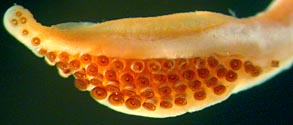
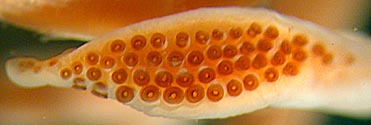

Top left -Tentacular club of P. lippula, syntype. Oblique-oral view. Drawing from Chun (1910). Top right - Tentacular club of P. lippula. Oblique-oral view, 56 mm ML, immature female, 35.2°N, 49.1°W, preserved. Note the terminal pad. Bottom left - Oral view of same club. Note that the suckers are larger in the ventral series. Bottom Right - Aboral view of same club.
 Click on an image to view larger version & data in a new window
Click on an image to view larger version & data in a new window
Figure. Oblique-oral view of the club of P. lippula, 35 mm ML, Hawaiian waters, preserved. Note the distinct keel and general similarity to the club above from the Atlantic specimen. Photographs by R. Young.
Scanning electron micrographs of the suckers can be seen here.
- Head
- Beaks: Descriptions can be found here: Lower beak; upper beak.
- Beaks: Descriptions can be found here: Lower beak; upper beak.
- Funnel
- Funnel valve absent.
- Locking apparatus broad with deep central groove and with a low, broad antitragus present.
 Click on an image to view larger version & data in a new window
Click on an image to view larger version & data in a new window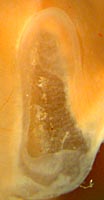
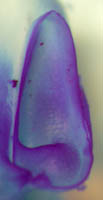
Figure. Funnel locking-apparatus of P. lippula. Left - 55 mm ML, 35.2°N, 49.1°W, preserved, unstained. Note the slight indication of a double nature of the antitragus. Right - 35 mm ML, Hawaiian waters, stained with methylene blue. Photographs by R. Young.
- Fins
- Each fin circular in outline.
- Measurements and counts
*Measured from proximal sucker and without straightening club.North Atlantic Hawaiian waters Sex Immature female Mantle length 56 mm 35 mm Fin length 25 mm 14 mm Fin width 37 mm 25 mm Arm I, length 15 mm 9 mm Arm II, length - 14 mm Arm III, length - 18 mm Arm IV, length 40 mm 28 mm Tentacle length 88 mm Club length* 5.7 Arm IV, suckers 19+ / 22+ 25
Comments
Chun's description is based on a 16 mm ML specimen and the head of a second specimen, taken from the same tow, estimated to have a ML of 20 mm. The above description is based on a series of small specimens taken from the central North Pacific and one larger (56 mm ML) squid taken from the North Atlantic. We have not been able to recognize differrences in specimens between oceans that would suggest they belong to separate species. Arm IV sucker counts on the holotype were found in notes we had taken of the holotype many years ago.
Nomenclature
This species was originally described as Doratopsis lippula by Chun (1908) but was transferred to Planktoteuthis by Pfeffer (1912).
Life history
The paralarva of P. lippula in Hawaiian waters is most easily separated from paralarvae of P. danae which is also common in Hawaiian waters, by:
- The central (rather than dorsal) position of the esophagus in the brachial pillar.
- Two (rather than one) chromatophores on the ventral midline near the arms (one is on the ventral base of the buccal mass). See arrows in Figure.
- Absence of a chromatophore ventrally between the eyes.



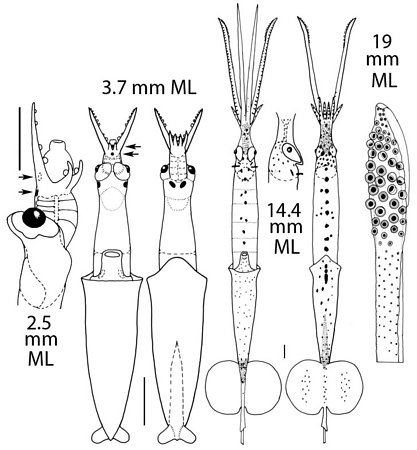
Figure. Paralarvae of Planctoteuthis lippula, Hawaiian waters. Thumbnail - Ventral views of the two primary paralarvae showing relative sizes. 2.5 mm ML - Side view of head showing the ventrally protruding eye, the central position of the esophagus, the relatively large number of chambers in the brachial pillar and the slender arms IV. 3.7 mm ML - Ventral and dorsal views of a small paralarva. 14.4 mm ML - Ventral and dorsal views and side view of head showing ventrally protruding eye. 19 mm ML - Oral view of tentacle-club. Distally the typical doratopsid club has large suckers and a keel, proximally a presumptive adult club with small suckers is present on the stalk; the latter suckers disappear in the juvenile. C - D - . Scale bar = 1 mm except for 2.5 mm paralarva where it is 0.5 mm. Drawings from Young (1991).
Comments
The 19 mm paralarva has a typical doratopsid club distally with large suckers and a keel. Proximally, however, a presumptive adult club with small suckers is present on the stalk, as is typical for most doratopsis stages; the latter suckers, in P. lippula, disappear in the juvenile stage. This arrangement confirms the general opinion (i.e., Roper and Young, 1967) that the adult Planctoteuthis club is a retention of the paralarval club.
Distribution
Type locality - Benguela Current, 11° 28' N., 10° 24' E.
Vertical distribution
In a study off Hawaii, Young (1978) captured 18 Planctoteuthis lippula. Two taken between 200 and 300 m were young squid that had not descended from the shallow, paralarval habitat. Except for a single night capture at 625 m, all other captures were from depths of over 700 m. The larger squid captured, sugest a further ontogenetic descent.

Figure. Vertical distribution chart of P. lippula, Hawaiian waters. Captures were made with both open and opening/closing trawls. Bars - Fishing depth-range of opening/closing trawl. Circle - Modal fishing depth for either trawl. Blue color - Night captures. Yellow color - Day captures. Arrows indicate that the trawl fishing depth extended beyond the limits of the chart. Chart modified from Young (1978).
Geographical distribution
This species is known only from the Atlantic and central Pacific Oceans.
References
Chun, C. 1908. Ueber Cephalopoden der Deutschen Tiefsee-Expedition, Zoologischer Anzeiger, 33: 86-89.
Chun, C. 1910. Die Cephalopoden. Oegopsida. Wissenschaftliche Ergebnisse der Deutschen Tiefsee-Expedition, "Valdivia" 1898-1899, 18: 1-522 + Atlas.
Pfeffer, G. 1912. Die Cephalopoden der Plankton-Expedition. Ergebniss der Plankton-Expedition der Humboldt-Stiftung. 2: 1-815.
Roper, C. F. E. and R. E. Young. 1967. A review of the Valbyteuthidae and an evaluation of its relationship with the Chiroteuthidae. Proc. U.S. Nat. Mus. 123: 1-9.
Young, R. E. (1991). Chiroteuthid and related paralarvae from Hawaiian waters. Bull. Mar. Sci., 49: 162-185.
Title Illustrations

| Scientific Name | Planctoteuthis lippula |
|---|---|
| Location | Hawaiian waters |
| Specimen Condition | Fresh |
| View | Side |
| Size | 35 mm ML |
| Image Use |
 This media file is licensed under the Creative Commons Attribution-NonCommercial License - Version 3.0. This media file is licensed under the Creative Commons Attribution-NonCommercial License - Version 3.0.
|
| Copyright |
©

|
About This Page

University of Hawaii, Honolulu, HI, USA

Smithsonian Institution, Washington, D. C., USA
Page copyright © 2016 and
 Page: Tree of Life
Planctoteuthis lippula .
Authored by
Richard E. Young and Clyde F. E. Roper.
The TEXT of this page is licensed under the
Creative Commons Attribution-NonCommercial License - Version 3.0. Note that images and other media
featured on this page are each governed by their own license, and they may or may not be available
for reuse. Click on an image or a media link to access the media data window, which provides the
relevant licensing information. For the general terms and conditions of ToL material reuse and
redistribution, please see the Tree of Life Copyright
Policies.
Page: Tree of Life
Planctoteuthis lippula .
Authored by
Richard E. Young and Clyde F. E. Roper.
The TEXT of this page is licensed under the
Creative Commons Attribution-NonCommercial License - Version 3.0. Note that images and other media
featured on this page are each governed by their own license, and they may or may not be available
for reuse. Click on an image or a media link to access the media data window, which provides the
relevant licensing information. For the general terms and conditions of ToL material reuse and
redistribution, please see the Tree of Life Copyright
Policies.
- Content changed 16 November 2016
Citing this page:
Young, Richard E. and Clyde F. E. Roper. 2016. Planctoteuthis lippula . Version 16 November 2016 (under construction). http://tolweb.org/Planctoteuthis_lippula/19495/2016.11.16 in The Tree of Life Web Project, http://tolweb.org/











 Go to quick links
Go to quick search
Go to navigation for this section of the ToL site
Go to detailed links for the ToL site
Go to quick links
Go to quick search
Go to navigation for this section of the ToL site
Go to detailed links for the ToL site